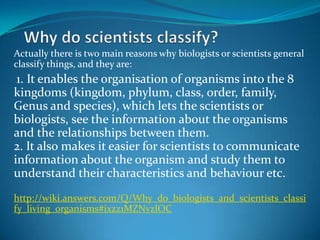
powerpoint Brugo, Rodrigues Piola y Serra
- 1. Why do scientistsclassify? Actually there is two main reasons why biologists or scientists general classify things, and they are: 1. It enables the organisation of organisms into the 8 kingdoms (kingdom, phylum, class, order, family, Genus and species), which lets the scientists or biologists, see the information about the organisms and the relationships between them. 2. It also makes it easier for scientists to communicate information about the organism and study them to understand their characteristics and behaviour etc. http://wiki.answers.com/Q/Why_do_biologists_and_scientists_classify_living_organisms#ixzz1MZNvzlOC
- 3. Levels of classification ·1)Kingdom ·2)Phylum ·3)Class ·4)Order ·5)Family ·6)Genus ·7)Species Source: http://www.quia.com/pp/51115.html?AP_rand=248964290 Nowadays there are 6 different kingdoms
- 4. WhatisBynominal nomenclature? Binomial nomenclature is the system used to identify all organisms on Earth, from elephants to algae. A binomial or scientific name identifies an organism by its genus and species, ensuring that everyone understands which organism is under discussion. Binomial nomenclature fits within the larger framework of taxonomy, the science of categorizing living organisms and assigning traits to them to understand the links and differences between them. The scientific name of an organism could be considered its definitive name, with scientific names being understood by scientists all over the world.
- 5. ·Lady bugscientificname: (Insecta: Coleoptera: Coccinellidae) ·Puma Concolor scientificname: Puma (Felis) concolorLinnaeus ·Willow Tree Scientific name: Salix lasiandra. ·Polar Bear scientific name: Ursusmaritimus or Thalarctosmaritimus. http://wiki.answers.com/Q/ http://web4.audubon.org/bird/at_home/pdf/Plantpro_Watchlist_WMD1.pdf
- 6. How are organismsClassified? The prime importance of classification of animals is to facilitate the arrangement of animals together which are alike (Similar morphology) and differentiate those which are unlike. The field of science applicable to study the classification of animals is called as taxonomy. In order to study animal’s characteristics, Scientists classified them according to their Kingdom, Phylum, Class, Order, Family, Genus and Species. Organisms can be distinguished into two main groups, vertebrates (with a backbone) and invertebrates (without a backbone). Organisms can be further subdivided into 20 phyla, which are of evolutionary importance. Altogether, around 800,000 species of animals have been identified so far. http://www.tutorvista.com/biology/importance-of-classifying-organisms
- 7. Majorplantsgroups: Mosses 1)This plant divisions are found in moist areas and do not grow vertically too high but can spread out to be a yard long. Conifers 2) This plant division bears cones, instead of real fruits. Ferns 3)This plant division can mostly found in tropical rain forests.
- 8. Flowers 4) The four basic parts of this plant division are sepals, petals, stamens and carpels. http://www.virted.org/Plants/Ferns.html http://www.virted.org/Plants/Mosses.html http://www.virted.org/Plants/Conifers.html
- 9. Group: Brugo Cecilia Rodriguez Piola Bautista Serra Cambaceres Victoria